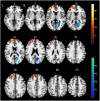Increased spontaneous activity of the superior frontal gyrus with reduced functional connectivity to visual attention areas and cerebellum in male smokers
- PMID: 37007679
- PMCID: PMC10063805
- DOI: 10.3389/fnhum.2023.1153976
Increased spontaneous activity of the superior frontal gyrus with reduced functional connectivity to visual attention areas and cerebellum in male smokers
Abstract
Background: Chronic smokers have abnormal spontaneous regional activity and disrupted functional connectivity as revealed by previous neuroimaging studies. Combining different dimensions of resting-state functional indicators may help us learn more about the neuropathological mechanisms of smoking.
Methods: The amplitude of low frequency fluctuations (ALFF) of 86 male smokers and 56 male non-smokers were first calculated. Brain regions that displayed significant differences in ALFF between two groups were selected as seeds for further functional connectivity analysis. Besides, we examined correlations between brain areas with abnormal activity and smoking measurements.
Results: Increased ALFF in left superior frontal gyrus (SFG), left medial superior frontal gyrus (mSFG) and middle frontal gyrus (MFG) as well as decreased ALFF in right calcarine sulcus were observed in smokers compared with non-smokers. In the seed-based functional connectivity analysis, smokers showed attenuated functional connectivity with left SFG in left precuneus, left fusiform gyrus, left lingual gyrus, left cerebellum 4 5 and cerebellum 6 as well as lower functional connectivity with left mSGF in left fusiform gyrus, left lingual gyrus, left parahippocampal gyrus (PHG), left calcarine sulcus, left cerebellum 4 5, cerebellum 6 and cerebellum 8 (GRF corrected, Pvoxel < 0.005, Pcluster<0.05). Furthermore, attenuated functional connectivity with left mSGF in left lingual gyrus and PHG displayed a negative correlation with FTND scores (r = -0.308, p = 0.004; r = -0.326, p = 0.002 Bonferroni corrected).
Conclusion: Our findings of increased ALFF in SFG with reduced functional connectivity to visual attention areas and cerebellum subregions may shed new light on the pathophysiology of smoking.
Keywords: amplitude of low frequency fluctuation (ALFF); cigarette smoking; functional connectivity (FC); superior frontal gyrus; visual attention.
Copyright © 2023 Niu, Gao, Lv, Zhang, Dang, Sun, Wang, Wei, Cheng, Han and Zhang.
Conflict of interest statement
The authors declare that the research was conducted in the absence of any commercial or financial relationships that could be construed as a potential conflict of interest.
Figures



Similar articles
-
Exploring spontaneous brain activity changes in high-altitude smokers: Insights from ALFF/fALFF analysis.Brain Cogn. 2024 Nov;181:106223. doi: 10.1016/j.bandc.2024.106223. Epub 2024 Oct 8. Brain Cogn. 2024. PMID: 39383675
-
Disturbed spontaneous brain-activity pattern in patients with optic neuritis using amplitude of low-frequency fluctuation: a functional magnetic resonance imaging study.Neuropsychiatr Dis Treat. 2015 Dec 16;11:3075-83. doi: 10.2147/NDT.S92497. eCollection 2015. Neuropsychiatr Dis Treat. 2015. PMID: 26719692 Free PMC article.
-
Aberrant Intraregional Brain Activity and Functional Connectivity in Patients With Diarrhea-Predominant Irritable Bowel Syndrome.Front Neurosci. 2021 Sep 3;15:721822. doi: 10.3389/fnins.2021.721822. eCollection 2021. Front Neurosci. 2021. PMID: 34539337 Free PMC article.
-
Common and distinct patterns of intrinsic brain activity alterations in major depression and bipolar disorder: voxel-based meta-analysis.Transl Psychiatry. 2020 Oct 19;10(1):353. doi: 10.1038/s41398-020-01036-5. Transl Psychiatry. 2020. PMID: 33077728 Free PMC article. Review.
-
Altered Patterns of Amplitude of Low-Frequency Fluctuations and Fractional Amplitude of Low-Frequency Fluctuations Between Amnestic and Vascular Mild Cognitive Impairment: An ALE-Based Comparative Meta-Analysis.Front Aging Neurosci. 2021 Aug 31;13:711023. doi: 10.3389/fnagi.2021.711023. eCollection 2021. Front Aging Neurosci. 2021. PMID: 34531735 Free PMC article.
Cited by
-
Exploration of Hippocampal Functional Connectivity Alterations in Patients with High Myopia via Seed-Based Functional Connectivity Analysis.Clin Ophthalmol. 2023 Nov 14;17:3443-3451. doi: 10.2147/OPTH.S434797. eCollection 2023. Clin Ophthalmol. 2023. PMID: 38026590 Free PMC article.
-
Smoking and High-Altitude Exposure Affect Intrinsic Neural Activity: A fMRI Study of Interactive Effects.Addict Biol. 2025 Apr;30(4):e70042. doi: 10.1111/adb.70042. Addict Biol. 2025. PMID: 40272188 Free PMC article.
-
Thalamic functional connectivity on 7-Tesla magnetic resonance imaging and its relation to motor signs in early-stage Parkinson's disease.Quant Imaging Med Surg. 2025 Jan 2;15(1):623-635. doi: 10.21037/qims-24-1498. Epub 2024 Dec 18. Quant Imaging Med Surg. 2025. PMID: 39839040 Free PMC article.
-
The structural and functional brain alternations in tobacco use disorder: a systematic review and meta-analysis.Front Psychiatry. 2025 Apr 11;16:1403604. doi: 10.3389/fpsyt.2025.1403604. eCollection 2025. Front Psychiatry. 2025. PMID: 40291519 Free PMC article.
References
LinkOut - more resources
Full Text Sources

